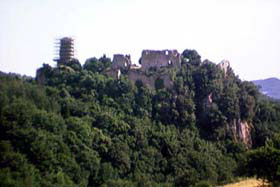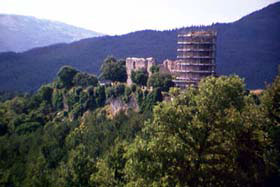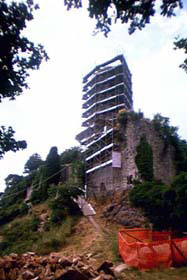Rocca Silvana
 |
 |
| Two views of the fortress. | |
The imposing ruins of the Rocca Silvana rise around a kilometer out of the inhabited center of the Selvena country along the road that conducts to Sovana. It can be reached following the ss2 Cassia up to the alternative for Abbadia S.Salvatore/Piancastagnaio or, entering for a brief line in the Lazio, from that for Porcena.
Rocca Silvana, called also Rocca Selvena or Roccaccia Selvena, today reduced to imposing ruins, was in the Middle Ages the most important fortifications of the Mount Amiata area, being one of the principal castles, almost surely the richest, of the most powerful feudal dynasty of the time: the Aldobrandeschi. Its wealth was due to the near layers of cinnabar and mercury excavated before the year 1000 and to its position to the the peak of a rocky hill of almost six hundred meters high with a precipice on three sides overlooking the valley of the river Fiora that conferred upon Rocca Silvana its impregnability.
 |
|
The tower set at defense of the main entry. |
The castle is named in a document of 833 A.D. from the Abbey of S.Salvatore but the most ancient traces brought to light during the recent excavations initiated in 1997 reveal nothing from before XI century. This was the period during which the monks of the above mentioned Abbey began to vindicate the possession of Selvena accusing the Aldobrandeschi to have taken it illegally. The feudal family won the quarrel, but the fortress continued in the following centuries to be object of desire and suffered under the siege of troops of Fredrick Barbarossa at the mid -13th century and subsequently was disputed between the powerful towns of Siena and Grosseto. Only at the mid-14th Century Siena took control on the territory, but only for few years. Selvena became in fact part of the fief of Pitigliano checked by the Orsini family and then of the Granduchy of Tuscany.
The ruins of the fortress dominate the landscape and it is today still easy to recognize the trace of the double walled enclosure, the first which enclosed the inhabited area and the latter the feudal palace , with a trapezoidal form. To the eastern high point of the second entourage, corresponding to the main gate, rises a splendid tower with a pentagonal form that had the function of keep. This tower seems to have been added to the fortification immediately after the siege of the Barbarossa to increase its defenses. The quality of the construction it is evident today, all performed with worked stones, that testifies to the wealth of the owners of the castle. This side of the fortification is also the only one defended not naturally by a precipice and the walls form here the vertex of their trapezoidal course almost creating a ba rbican to defend the entrance. At the side of the tower, almost in the center of the second enclosure, rose the rest of the feudal palace, one of the finest examples of residential architecture of the 13th century that we can find in Tuscany outside of the big cities. All around we found various remains of other buildings between which the cistern and the chapel can be still identified. The complex remained in use up to the whole 17th century and, after the exhaustion of the mines that gave it importance, it began a slow decline. Its position like that of a hardly accessible eagle nest, led to its abandonment. Until the year 1997 it was also risky to venture between these ruins that were entangled with vegetation becasue of the danger of of collapsing. Luckily the recent restoration work has stablizied the remains, but years will be needed before we'll be able to enjoy its results. Today Rocca Silvana is visible only from the varied perspectives that offers us the panoramic road that leads to Sovana.
| Back to Homepage |
| Back to Castles Index |